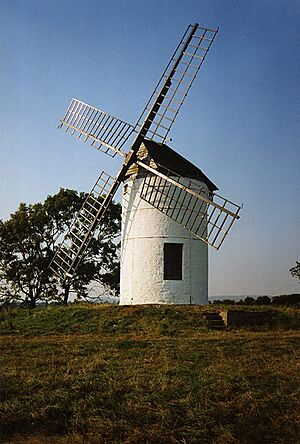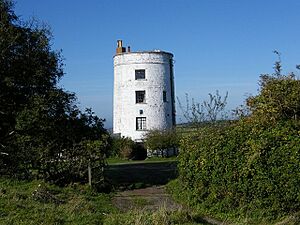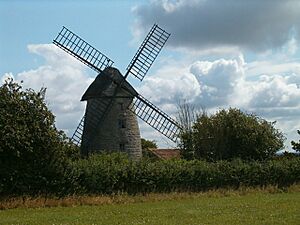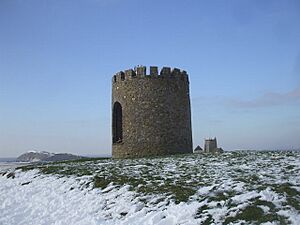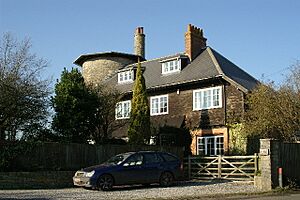List of windmills in Somerset facts for kids
This article explores the history of windmills in Somerset, a county in England. Windmills are amazing machines that use the power of the wind to do work, like grinding grain into flour or pumping water. For hundreds of years, they were a vital part of life, helping communities produce food and manage water. Somerset, with its varied landscapes, has been home to many different types of windmills over the centuries. Some are still standing today, while others are just memories found in old maps and records.
Contents
What is a Windmill?
A windmill is a machine that uses the energy of the wind to turn large sails or blades. These sails then power machinery inside the mill. The most common use for windmills was grinding grain into flour. This was a super important job before electricity, as it helped make bread and other foods. Windmills also pumped water, especially in low-lying areas, to keep fields from flooding.
Types of Windmills You Might Find
Over time, different designs of windmills were developed. Each type had its own way of catching the wind and transferring its power.
Tower Mills
Tower mills are usually tall, round buildings made of stone or brick. Their main body stays still, but the cap (the top part) can turn to face the wind. This means the miller only had to move the cap and sails, not the whole building! This design made them very strong and able to stand up to powerful winds. Many tower mills were built from the 18th century onwards.
Post Mills
Post mills are one of the oldest types of windmills. The entire body of the mill, which holds all the machinery, is built on a single, large wooden post. This means the whole mill had to be turned by hand to face the wind. Imagine pushing a whole building around! They were common from the medieval period up until the 19th century. Some post mills were "sunk post" mills, where the main post was buried deep in the ground for extra stability.
Wind Engines
Later on, especially in the late 19th century, smaller metal windmills called "wind engines" became popular. These were often used for pumping water on farms or for small industrial tasks. They looked a bit like modern wind turbines, with many small blades. They were often made by companies like John Wallis Titt.
Famous Windmills of Somerset
Somerset has been home to many windmills, some of which are still standing or remembered today. Here are a few notable examples:
Ashton Windmill: Still Standing Tall
Located in Chapel Allerton, Ashton Mill is a famous tower mill. It was built around 1774 and is a great example of this strong type of windmill. While it no longer has its sails, the tower itself is a well-known landmark.
Stembridge Mill: A Historic Landmark
Stembridge Mill in High Ham is another important tower mill. It was built in 1822 and is one of the best-preserved windmills in Somerset. It shows us what these amazing structures looked like when they were working.
Uphill Mill: A Landmark on the Hill
The Uphill Mill in Uphill is a tower mill that was first mentioned in 1782. It stands on a hill and would have been a very visible landmark for miles around. Although its sails were removed in 1934, the tower remains.
Walton Mill: Rebuilt and Remembered
In Walton, there was a post mill that collapsed around 1725. But a new tower mill was built in its place in 1741! This shows how important windmills were to communities, as they would rebuild them if they were damaged.
Weare Mill: A Glimpse into the Past
Weare Mill was first recorded in 1760. It's a reminder of the many windmills that once dotted the Somerset landscape, helping local people with their daily needs.
Worle Mill: From Grinding to Gazing
The Worle Mill in Worle is a tower mill that was built around 1760. Interestingly, this mill has been repurposed! It's no longer grinding grain but serves a different purpose today, showing how old buildings can find new life.
Windmills Through the Ages
Windmills have been a part of Somerset's history for a very long time, with records going back centuries.
Early Windmills: The First Records
Some of the earliest mentions of windmills in Somerset date back to the 13th and 14th centuries. For example, a windmill was recorded in Glastonbury as early as 1244. These early mills were often post mills, simpler in design but very effective for their time. Locations like Berrow and Butcombe also had windmills in the 1330s.
The Rise and Fall of Windmills
Over the centuries, more and more windmills were built across Somerset. Places like Burnham on Sea and East Brent had several mills, sometimes at the same location over time. Many windmills were damaged or destroyed by strong storms, like the one in 1703 that blew down mills in Mark. As technology changed, especially with the invention of steam power and later electricity, windmills became less common. Many were demolished in the late 19th and early 20th centuries.
Modern Uses and Preservation
Today, most windmills in Somerset are no longer working mills. Some have been converted into homes, while others are preserved as historical monuments. They stand as a reminder of a time when wind power was essential for everyday life and show us how people used natural resources to build amazing machines.
Images for kids


